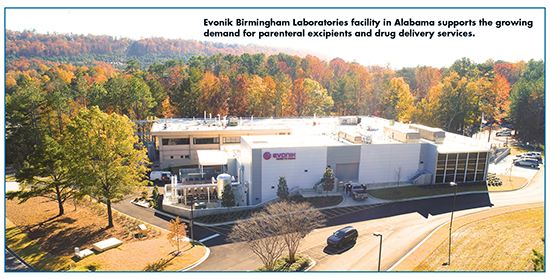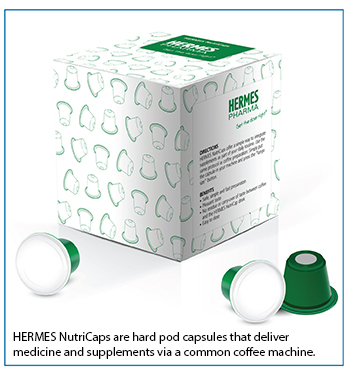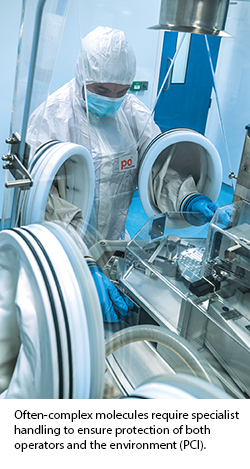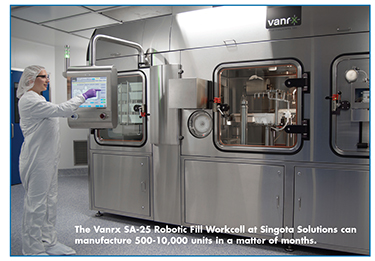Issue:June 2019
SPECIAL FEATURE - Outsourcing Formulation Development & Manufacturing: CDMOs Shift to Offer More Specialized Services
As drug products become more complex, there is increasing customer demand for relationships with contract development and manufacturing organizations (CDMOs) that have core competencies in highly specialized formulation and process technology areas.
One of these specialty areas is complex molecules. Biotech companies developing novel biologics are increasing in the market, thus there is an increase in outsourcing development services to BioCDMOs. To serve the needs of this market, companies like FujiFilm Diosynth Biotechnologies are expanding their bio capabilities to offer advanced manufacturing technologies. FujiFilm predicts the BioCDMO market to grow at more than 8% per year.1
Another area of expertise where pharma is relying on CDMOs is in cell and gene therapy. Industry insiders expect gene therapy manufacturing market to boom and grow at rates ranging from 15 to 20%.2 Benefits of partnering with a cell or gene therapy CDMO include scalability, speed to market, access to technical expertise without overhead costs, and cost efficiencies. Demand for specialized manufacturing and clinical trial support for cell and gene therapies has resulted in more than 40 companies offering these services.3 And the market continues to expand. As of press time, Catalent acquired gene therapy CDMO Paragon Bioservices for $1.2 billion. Catalent believes that the addition of this capability from the Maryland firm will help tap into the strong gene therapy market.
No matter the area of specialty, CDMOs find they must shift toward providing value-added services by establishing themselves as a one-stop-shop for pharma clients “When you work with multiple contract services organizations during the drug development and manufacturing process, it takes more time, increases costs, and involves greater risk,” says Robert Lee, PhD, President, Particle Sciences. “If there are five or six organizations working on different elements of the same project, it’s more difficult to manage and you need to ensure that someone is keeping track of all the players and arranging the logistics. For example, we’ve found that when another company does the analytical work for a client, we can wait weeks for the analytical data we need to help support our formulation efforts. When we do the analytical work ourselves, then those delays don’t happen and we are in control of the information flow.”
Working with a one-stop-shop means that everything is done in one place, removing time and risk mitigation concerns. This is a particularly critical issue when transferring between late-phase clinical to commercial. Dr. Lee says some CDMOs can get a pharma to Phase 1/2, but transferring a complex formulation to another CDMO can involve cost and time.
In this exclusive Drug Development & Delivery magazine annual report, several CDMOs discuss their formulation development and manufacturing capabilities for bio/pharma companies of all sizes.
Ascendia Pharma: In-House Nanotechnologies Screen Formulations
Project sponsors are looking for a CDMO that is flexible with a proven record of quality, and has the ability to complete the project quickly to the proof of concept stage. This can prove challenging for more complex compounds. An increase in API complexity, breadth and depth of formulation expertise in resolving compound physical-chemical and biopharmaceutical problems, and the ability to strengthen the intellectual property position of the client’s products are becoming a lead criterion when selecting a CDMO.
Jim Huang, PhD, CEO of Ascendia Pharma, says Ascendia’s one-stop-shop CDMO is adept at tackling a compound’s formulation challenges within a very tight time window. In one case, he says Ascendia was awarded a lipid project transferred from a previous CDMO. “Within 3-4 months, we did more than resolve the stability issue that would otherwise need a toxicity qualification for a new impurity,” he explains. “We enabled room temperature storage instead of ‘store under refrigeration,’ as well as resolved the formulation capsule’s incompatibility that was causing an extremely low yield. In another case for a SEDDS lipid formulation, we were able to improve the drug loading and increase the API bioavailability two- to three-fold from the original formula. The result was a dramatic reduction of dose burden from 25 capsules/day to less than 6 capsules/day.”
In addition to traditional formulation expertise in oral, controlled release, parenteral, and topical dosage forms, Ascendia often conducts formulation screening, development, and GMP manufacturing using its three in-house proprietary nanotechnologies: Nanosol, AmorSol, and EmulSol. “In most cases, the outcome of formulation in PK studies is outstanding, which enables a dramatic increase in bioavailability and a dose-expose linearity for GLP toxicity and first-in-man studies for new compounds or repurposing 505 (b)(2) products,” says Dr. Huang.
Cambrex: Responding to Formulation Trends & Regulatory Changes
As a full service CDMO, Cambrex is witness to many industry trends. First, as the market evolves, new products are being developed in smaller batch sizes than in the past, due in part to the increasing number of drugs being developed for selectively niche patient populations, explains Maryse Laliberté, Vice President & General Manager, Cambrex. “This is a change from the previous paradigm where historically drugs were developed with multiple indications in mind. We are currently seeing many new drugs in the pipeline being developed with a focus on very specific and orphan diseases.” She adds that more targeted, smaller patient populations have driven demand for a niche type of support, which can mean a more complex manufacturing process.
“As companies work on drugs for smaller patient populations, the reduced quantities of drug material required during the clinical trial process potentially means a more simplified supply chain and the sponsor company no longer has to manage multiple CDMOs as in the past,” adds James E. Cherry, Vice President, General Manager, Cambrex. “Additionally, developing for smaller populations reduces clinical trial costs and can help expedite the approval process for the product.”
When it comes to regulatory approval, Mr. Cherry says it is critical to understand that companies are looking for full support. This has caused a growing use of third-party consultants, as well as heavy reliance on the expertise of CDMOs. He says: “Particularly true is that smaller or virtual companies bringing new molecules to market are looking to work with a CDMO much earlier in the process — sometimes starting at clinical phases — and more often are keeping the product in house for longer, rather than the historic notion of licensing or divesting to Big Pharma after Phase 2. Drug complexity aside, two-thirds of new drug approvals in the clinical pipeline is coming from small and emerging pharma companies who are leaner than the traditional pharma companies in terms of support functions such as regulatory affairs.”
New regulations are coming into play with respect to pediatric dosage and formulation development. This is of particular importance to drug manufacturers seeking to create alternative formulations for younger patients. “The industry, and in particular Big Pharma, is placing a stronger focus on developing pediatric formulas as they look to extend their current patent on their existing adult formulas,” says Mr. Cherry.
Metrics Contract Services: Answering a Range of Formulation Development Requests
As a full-service CDMO, Metrics Contract Services has received requests for a range of formulations. Joe Cascone, Vice President, Metrics Contract Services, says dry granulation (roller compaction) has become the go-to granulation technique for solid-oral dosage, as it lowers the overall processing cost and helps avert potential stability-related challenges caused by moisture in the wet granulation technique. “State-of-the-art compactors, such as the Gerteis, have allowed development of robust roller compaction formulation for capsules as well as tablets.”
And, for powder-in-capsule formulations, a popular alternative to clinical formulations, he says clients are moving towards plant-based HPMC capsule shells instead of traditional gelatin capsules to accommodate patients who are mindful about from where excipients are derived and prefer plant-based options.
“Overall, sponsors have asked us to develop a variety of formulations, ranging from simple immediate-release dosage forms requiring direct-blend encapsulation to complex mixed-dosage forms with both immediate- and sustained-release attributes so patients can avoid taking multiple daily doses and improve their compliance,” says Mr. Cascone. “The choice of formulation depends on various factors, including biopharmaceutical, physicochemical properties, stability, and the pharmacokinetic properties of the API.”
Evonik: Competencies in Polymeric & Lipid Nanoparticle-Based Formulations
As a CDMO partner for advanced drug delivery, Evonik supports customers worldwide in the development and cGMP production of complex oral and parenteral drug products. Danielle Clay, Global Strategic Marketing and Business Development Director for Drug Delivery at Evonik, says that for oral drug products, demand continues to strengthen for functional excipients that enhance drug efficacy, improve patient compliance, and address poor solubility and low permeability. Recent program examples at Evonik include a desire for improved swallowability, the use of combination polymers, and the application of additive manufacturing technologies for the 3D printing of personalized oral solid dosage forms.

“For the development of oral drug products, we support customers across multiple functionality areas including immediate-, delayed-, and sustained-release, as well as specific custom areas such as colon targeting and pulsatile release,” she says. Areas of formulation focus include the development and production of orphan drugs for accelerated entry into clinical Phase 1or 2 trials, oncological drugs for early stage human clinical trials, and pediatric formulations such as multiparticulates and mini-tablets.
In the complex parenteral drug product space, Ms. Clay sees strong demand for formulations with high potency APIs, gene-based therapies such as mRNA, and extended-release microparticle or nanoparticle technologies. Formulation development requests for complex injectables cover a range of target product profiles but tend to focus more on precision delivery, improved efficacy, and better patient compliance. Formulation project examples include local delivery to the eye, knee, joint or tumor; achieving a specific rate and duration of API release; better penetrating target cells for improved API uptake; and reducing systemic toxicity. “We also see more companies undertaking early formulation feasibility studies, while demand for process development, scale up, and cGMP manufacturing continues to increase, especially for aseptic processing,” she says. For polymeric-based parenteral formulations, Evonik supports excipient selection and initial formulation feasibility testing through to commercial production and filling. “With many complex parenteral products requiring aseptic manufacturing, we are also experiencing strong demand for aseptic powder filling at both clinical and commercial scale,” says Ms. Clay.
Given the increasing complexity of oral and parenteral drug products, Ms. Clay says it is impossible for any CDMO to offer best-in-class services across every drug delivery technology. But, she says Evonik has established core competencies in the development and production of polymeric and lipid nanoparticle-based formulations.
HERMES PHARMA: Novel Formulations Easily Deliver Therapeutics
People are increasingly seeking ways to proactively improve their health and prevent problems, which has led to a growing market demand for personalized medicinal products and food supplements. As a whole, the increasing popularity of supplements has broadened the market for user-friendly dosage forms such as effervescent tablets, orally disintegrating granules and, most recently, hard pod capsules like HERMES NutriCaps.
“The latter are compatible with hard pod coffee machines and are used to prepare hot drinks containing the supplement or medicine,” explains Dr. Detlev Haack, Head of R&D at HERMRES PHARMA. Despite the novelty of the approach, Dr. Haack says this dosage form is gaining traction, with cough and cold remedies being the first treatments to be released in these pods. “The hard pods provide people with a quick, convenient, and safe way of taking food supplements. They not only meet the need for high-quality and tasty supplements, but their ease of use can help people comply with their health goals and feel empowered to achieve them.”

A further key advantage of hard pod capsules is that they can meet the demand for traceability in healthcare products, as the ingredients can be traced directly back to the farmer or to the company holding the nutrient.
“Most sponsors that approach us are looking to develop user-friendly dosage forms, as they recognize the continually growing demand and want to work with experts to develop a product line in this expanding market,” says Dr. Haack.
In a survey of 2,000 people in the US and Germany4, more than 50% of the participants reported difficulties swallowing traditional tablets and capsules, and about 40% said that they would prefer products that have a pleasant taste and are easy to integrate into their daily routines. As such, Dr. Haack says there is demand for products that are both easy to swallow and convenient to use. For example, orally disintegrating granules are popular for taking ‘on the go’ and instant drinks in sachets. However, he says, HERMES is increasingly being asked for novel forms like hard pods. “We’re frequently told by our customers that the demand for user-friendly products is continuing to grow, and we are committed to making the necessary investments to ensure we can meet the market need.”
When developing a novel form like the hard pod, Dr. Haack says risk analysis was conducted. “We anticipated that the authorities would ask whether coffee machines were safe ‘medical devices’ for preparing medicinal drinks. In our risk analysis, we found strong evidence that using a coffee machine is much safer than preparing hot water in a kettle. We also found that using the hard pods with a coffee machine enables consistent, correct doses, with the freshly prepared drink remaining stable for at least an hour after preparation.”
Currently, HERMES is developing a new user-friendly dosage form of an existing treatment for cystitis. The treatment consists of D-Mannose, a naturally occurring sugar that prevents bacteria from attaching to the bladder lining. “We originally identified the product in a powder dose form in Eastern Europe, where it is manufactured as a widely-used dietary supplement to support urinary tract health,” Dr. Haack explains. “In clinical tests, we discovered that D-Mannose is just as effective against cystitis as antibiotics and, even more interestingly, it doesn’t produce any side effects. Its original powder form did not optimize compliance, as it needed to be dissolved in water three times daily. This revealed a clear need for a more user-friendly and convenient dosage form, which we are currently developing as a HERMES NutriCap hard pod. This highlights how CDMOs can develop new, optimized dosage forms for existing effective therapeutics, providing low-risk opportunities to enter a growing and potentially profitable market.”
Particle Sciences: Tackling Challenges of Poorly Water-Soluble Molecules
A number of factors in the market are reshaping the approach to dosage forms, resulting in a rise in non-traditional dosage forms such as nasal sprays and drug-eluting implants. One reason for taking these new approaches is the number of drugs that contain poorly water-soluble APIs.
“When poorly water-soluble drugs are delivered through traditional dosage forms such as oral solid dose, they fail to dissolve, have severely limited bioavailability, and therefore have limited therapeutic effect,” says Robert Lee, PhD, President, Particle Sciences. “There are multiple techniques available to increase the solubility or dissolution rate of drugs and improve their delivery, particularly the use of amorphous solid dispersions and nanoparticle formulations.”
Alongside the issue of poor solubility is the increase in 505(b)(2) approvals – an FDA regulatory pathway that involves taking existing, marketed APIs into a different route of administration. These approvals grew 50% last year and this regulatory path has become increasingly popular over the last decade, usually involving innovative dosage forms or drug delivery methods that are considered complex, explains Dr. Lee.
“Navigating the regulatory pathway and ensuring a molecule reaches the clinical trial phase is relatively straightforward for simple dosage forms such as an oral solid dose or a sterile injectable solution, but with more complex formulations involving nanoparticles, there are a lot of layers,” he says. “It’s hard enough to develop a complex formulation that tackles poor solubility without the added obstacle of inadequate regulatory knowledge that could see a product fall at the first hurdle.”
Preventing failures related to complex formulation challenges is something Dr. Lee takes seriously. “Clients sometimes come to us with formulations that have been developed on benchtop only or by organizations that just don’t have experience in complex dosage forms,” he explains. “We take on these sub-optimal formulations and use a more scalable process in conjunction with optimizing the formulation to make a much better product that is acceptable for GMP production and commercial production.”
When the API is a particularly challenging molecule, it is important to come up with better formulation methods. For example, one molecule Particle Sciences worked on recently was poorly water soluble. Dr. Lee says a novel formulation was identified that was comprised of GRAS liquids that had strong solubilization characteristics, and Particle Sciences filed a provisional application. “This approach enabled us to produce a solution with the required pharmacokinetic profile to match the commercial product given by a different route of administration,” he says. “By doing so, we were able to provide our client with additional intellectual property protection for their asset.”
PCI Pharma Services: Troubleshooting Challenges of Potent Products
Over the last year, PCI has seen a continued increase in the number of highly potent molecules at early-stage development. These often-complex molecules require specialist handling to ensure protection of both operators and the environment. Additionally, APIs can be in short supply, expensive, and time-critical in terms of the development program.
“Clients are seeking suppliers who are experienced in the handling of such molecules able to offer multiple options in terms of the development pathway,” says Kat Jones, Director of Marketing and Commercial Operations, International, PCI Pharma Services.

PCI has seen an increase in requests for early-stage drug-in-capsule (DIC) technologies whereby the API is filled directly into capsules either as neat API or a simple blend formulation. This approach, says Ms. Jones, enables the client to either accelerate the development program further or to ‘fail and fail fast,’ therefore delivering both time and cost efficiencies.
“We are being asked to tackle almost all formulations as expected for any CDMO, with a high percentage being solid oral dosage forms,” she says. “In the last 12-18 months, however, we have experienced a significant increase in development and manufacturing programs where the final dosage required is a nonsterile oral liquid, a high proportion of which are also classified as highly potent. As with the manufacturing of a solid oral dosage form, any drug product in liquid form containing a highly potent API is subject to specialist handling requirements with additional controls.”
And, as with any CDMO, challenges arise. A recent example involved a formulation whereby the active was classified as potent. The product contained a very low dosage within the tablet core of a sustained-release formulation, explains Ms. Jones. “When the previous CDMO was unable to meet the assay and content uniformity requirements, PCI was approached to transfer the product, troubleshoot the challenges, and ultimately deliver the product.”
PCI transferred the existing processing parameters using a specifically designed mathematical scaling model. “We performed a full Design of Experiment (DoE) program with the aim of investigating the critical processing parameters on the influence of the assay and content uniformity results,” she explains. “Eight experiments were conducted and analyzed alongside a review of the data from the previous CDMO. We identified a number of variables and the DoE analysis indicated that the assay value and content uniformity would be more desirable if high spray rate was avoided at low atomizing pressure.”
As a result, the robustness batches were manufactured using the optimized design space identified during the DoE experiments with the batches confirming the statistical design space. The newly developed processing parameters were translated into master batch records for clinical Phase 2 studies. “The favorable results meant we were able to scale up the batch size and proceed to Phase 3, validation, and subsequent commercial supply on behalf of the client,” she says.
Recro Gainesville: Managing Challenging Molecules From Early-Stage Feasibility to Commercialization
As a CDMO with expertise in oral solid dosage pharmaceuticals, Recro Gainesville is most often asked to tackle formulation and process development for tablets or capsules ranging from benchtop feasibility through clinical supply manufacturing or technical transfer. Often, these projects are challenging because they include specific combinations of special needs such as modified release, solvent processing, multi-step processes, and/or involve controlled substances, explains Richard Sidwell, PhD, Vice President and Chief Scientific Officer, Recro Gainesville. “In the past few years, there has been a trend towards more complex formulations involving multiple intermediate steps. Fixed-dose combinations and modified-release dosage forms with unique release profile requirements are becoming more common,” he says. “For example, we have received multiple inquiries for fixed-dose combinations in which the release needs to be controlled for one or both APIs, often with slightly different release characteristics.

In addition, Dr. Sidwell says the CDMO has seen more early-stage feasibility work for challenging molecules. Developing an early understanding of the API (and later the formulation and the process) ultimately leads to positive outcomes during scale up and generates a knowledge database to address questions that may arise during investigations or review. “The early-stage feasibility work may include pursuing multiple delivery strategies or identifying an optimal trade-off between drug delivery optimization and processing complexity,” he says.
Having clients start with Recro for early drug product development studies and stay with Recro through clinical supply manufacturing and commercial launch remains a central focus of the CDMO. Dr. Sidwell says: “Building relationships with clients during early development work and then continuing into later phase manufacturing not only promotes technical (i.e. process knowledge) continuity, but also supports development of a robust regulatory filing strategy.”
Understanding the filing requirements and strategies at different phases of development can help create a more streamlined development path overall, he adds. “Without an understanding of regulatory requirements for an NDA, it is easy for early success in the clinic to lead you far down the development pathway without maintaining sufficient CMC support in terms of materials, formulation, and process understanding,” he says. “Once the shortcomings of the CMC development package become apparent, it can be expensive and time-consuming to step back and rectify, particularly when the pressure is on to file ASAP. A strong understanding of regulatory requirements and a forward-thinking approach can help avoid the risks of late-stage problems or dead-ends that might lead to a need for repeat clinical work.”
Singota Solutions: Capabilities Tailored to Specific Client Needs
At Singota Solutions, robotic aseptic filling is done in a completely gloveless workcell, providing repeatable precision fills with reduced particulate counts versus conventional technology, claims Ken Chomistek, Director of Quality Control and Development at Singota Solutions. “Our gloveless robotic filling isolator allows us to take a formulation from project inception to filled units in a few short months versus nine months (or more) by other CDMOs,” he says. “Our system is ideally suited for the production of clinical and niche commercial injectable products in vial, syringe, and cartridge formats.”

Singota’s manufacturing facility can handle a range of small-molecule and biological formulations, including potent compounds. Mr. Chomistek says that Singota witnessed an increased interest from clients for small quantity batch filling for both vials and prefilled syringes of parenteral formulations. “Being able to aseptically manufacture 500-10,000 units in a couple months can save money, time, and can provide a first to clinic advantage over competition.”
As an example, he explains how Singota worked with a client to design dosing studies for its product. “Initially, they had a vial that required clinicians to measure patient dosing for each injection. We helped optimize small-volume fills in prefilled syringes –– as an alternative to the vials –– to reduce potential errors in the clinic.”
Manufacturing at Singota goes hand in hand with formulation development, which Mr. Chomistek states is a ‘simple is better’ approach. “Our clients want more efficiency out of their excipients,” he says. “If a single excipient can have multifunctionality, it can keep the formulation simpler and easier to manufacture and test down the road. As a result, clients are regularly challenging us to help them to find, evaluate, and report on new excipients and their multifunctionality.”
Dr. Reddy’s Custom Pharma Services: Starting With the End in Mind Mitigates Risk
Custom Pharma Services (CPS) at Dr. Reddy’s is a one-stop-shop CDMO, delivering 170-plus projects and working with more than 200 customers globally. CPS supports pharmaceutical companies across the value chain of development to commercial manufacturing; from intermediates and drug substances to drug product formulations.
“Extensive understanding of regulatory requirements for INDs, clinical phases, and NDA filing programs enables CPS to customize product solutions as ‘fit-for-purpose,’ says Rashmi Nair, Technical Manager-Business, Dr. Reddy’s. “With state-of-the art R&D and GMP facilities that are inspected by stringent regulatory authorities, best industry practices for documentation through electronic note books and a range of technologies, services, and scales of operation, CPS ensures time and cost-effective product solutions.”
CPS adopts a ‘start-with-the-end’ approach and considers formulation as the eventual deliverable of any drug development program irrespective of the scope of project: intermediates, API or formulation. This approach helps envisage risks, required precautions, and commercial viability, and support customers with a partner approach, not as a mere service provider, says Ms. Nair. This approach benefited a small biotech in Europe. The customer approached CPS for process development of the API, an anti-infective high dose drug. It was for a clinical Phase 2 program. The API process required chemical synthesis, conversion to amorphous solid by spray drying, and then a granulated blend filled in sachets as a formulation. This process was an 8-day activity at the API stage and a 3-day activity at formulations, with frequent issues in powder flow during sachet filling. Ms. Nair says the CPS team proposed a process simplification approach with in-situ amorphization and particle design in a manner that modified API micromeritcs-generated densified material for formulation. With customer approval, a proof-of-concept was established utilizing process analytical technology such as Focused Beam Reflectance Measurement and Particle Vision Measurement, and gram scale prototypes. “With close coordination of the API and formulation teams, a go-to-market product was developed,” she says. “Today the drug program is in clinical Phase 3 and utilizes this new process, saving the customer about 27% more cost and 35% more time than the original process.”
Almac Pharma Services: Flexibility to Meet Varied Client Needs
According to John McQuaid, Vice President Technical Operations, Almac Pharma Services, there are two key benefits to working with a full-service CDMO: efficiency and continuity. “We streamline the transfer of goods as they move from drug substance development and manufacture to drug product development and manufacture, then on to clinical packaging,” he says. “This saves valuable time in the overall clinical supply chain.”
Mr. McQuaid says that a full-service CDMO like Almac also streamlines the transfer of know-how at each step, with interdisciplinary teams that share expertise across the transitions. “Clients benefit from having one highly skilled technical team capable of developing the formulation and analytical method in-house, then carrying it through to clinical trial material manufacturing, scale up, and ongoing commercial supply. In short, we ensure that product-specific knowledge gained over several years is maintained.”
One area in which Almac has specific knowledge is in pediatric formulations, which has increased in interest over the past year, says Mr. McQuaid. “The increased interest in pediatric formulations is driving a demand for powder-in-bottle, mini-tablets, and stick packs. API-in-capsule using Capsugel’s Xcelodose® technology remains popular, and clients have expanded their use of it from Phase 1 clinical trials into Phase 2 and beyond.”
One Almac client had a commercialized adult dosage form that needed a corresponding pediatric dosage form with multiple dosage strengths in an easy-to-use packaging format. Mini-tablets filled into stick packs were identified as the best presentation. “Mini-tablet development differs from standard tablet development,” says Mr. McQuaid. “Nevertheless, Almac successfully optimized several equipment features: punch tip concavity; ejection scraper design; ejection cam position; and punch and turret keyways. We also custom-designed 37-tip punches that allowed compression rates up to 550,000 mini-tablets per hour. We customized a packaging solution as well. In conjunction with a third-party specialty vendor, the team successfully identified, installed, and qualified stick-pack filling equipment.”
In addition to pediatric formulation knowledge, Almac has regulatory experience to handle complex drug products. “As products become more complex and the regulatory requirements becomes more exacting, clients are looking to us to shoulder more of the burden,” he explains. “On the front end, our documentation can be dropped easily into clients’ regulatory submissions with little editing. We have also drafted entire sections of clients’ submissions on their behalf. On the back end, our quality and regulatory experts work with clients to ensure smooth and successful inspections.”
Almac is also being asked to take on commercial supply of clients’ products, often at, or close to, the same scale provided for clinical studies. This, says Mr. McQuaid, is occurring as there is an industry trend toward higher value, lower volume products. “Our production facilities span pilot to large scale, so we’ve had success meeting our clients’ increasingly varied demands.”
This flexibility is how Mr. McQuaid says Almac differentiates itself from other CDMOs. “Once we understand our clients’ objectives, we can customize the best business solution. For example, traditional fee-for-service relationships still work for some of our clients, but for many others, a more strategic partnership is preferable. In those instances, they may opt to secure dedicated capacity, equipment, or GMP floor space to meet their business demands.”
References
- FujiFilm to Invest 10 Billion Yen in its BIO CDMO Business, Jan. 7, 2019, https://www.fujifilmusa.com/press/news/display_news?newsID=881569.
- Gene Therapy Manufacturing Partnership to Support ‘Booming’ Market, Maggie Lynch, OutsourcingPharma.com, Dec. 3, 2018, https://www.outsourcingpharma.com/Article/2018/12/03/Gene-therapy-manufacturing-partnership-to-support-booming-market.
- Contract Manufacturing for Cell and Gene Therapies, BioInformant, https://bioinformant.com/product/cell-gene-therapy-cdmo/.
- Market Study Summary: A Hard Truth to Swallow? HERMES Pharmaceutical and SPIEGEL INSTITUT Mannheim, https://www.swallowingtablets.com/.
To view this issue and all back issues online, please visit www.drug-dev.com.

Cindy H. Dubin is an award-winning journalist who has been reporting on the pharmaceutical industry for more than 18 years about a variety of topics, including formulation development, drug delivery, and drug quality.
Total Page Views: 10263









